Whenever I hear or read about the ↑quantified self—a lifestyle obviously deeply influenced by the heritage of ↵cybernetics—I am reminded of conversations I led and overheard while I still was visiting the gym regularly, three times a week. Already when just eavesdropping I was amazed by the topics the real bodybuilders talked about. The weights lifted almost aren’t a topic at all—with the exception when they spot somebody they care about using too heavy weights. This not only has negative training effects but greatly heightens the risk of injuries, too. Then, somewhat related to the former, there is the topic of correct execution of the exercises. But, roughly estimated, almost eighty percent of the conversations the big boys lead is filled with training plans and nutrition en détail. This was corroborated once I could take part in the discussions, after having been socially accepted by the circle of the big boy regulars at my gym—doing ten repetitions in the fifth set with 90 kgs on the bench is the threshold, I guess. Not that I myself was a big boy then, far from it, but to their satisfaction they had seen that I was serious about their sport and cared for it. Exactly the same experience I had with all communities of practice I ever had to do with, be they composed of hardcore gamers, game modders, Karatekas, or whatyouhave. Once you have demonstrated respect, prolongued interest, and willingness to invest, you’re in.
Anyway, back on topic. It’s obvious that the ↑quantified self movement has its roots not only in cybernetics, but also in flight medicine, sports science, and the like. I always thought that sooner or later the practices and scenes of the gym will be reconnected with the quantified self. Bruce W. Perry’s book ‘Fitness for Geeks’ (2012) does it.
Unqualified addendum: You people must have time …
moving the map
Here is yet another example from the ↵games with defects: ↑PlaygroundPong. From ↑the documentation:
PlaygroundPong is a proof of concept for inverting Avatar & Playground. The player cannot move the paddles at all like in a regular Pong game. The ball seems to move from side to side but clearly it does not! The player cannot identify with the avatar (playing object), he or she has to get to terms with moving the background (from left to right, right to left, top to bottom and bottom to top) in order to bring the paddles in a position where they manage to hit the ball back. The paddles themselves slightly move up and down according to what direction the player moves the playground to. An utterly unfamiliar set up for a player who expects to play and navigate an avatar. He or she now plays the playground and tries to keep avatars and object in position. The player needs to rewire his or her brain before succeeding with the inverted gameplay.
This reminded me of two fine ↑Quake-related Chuck-Norris jokes: ‘When Chuck Norris rocket jumps, he doesn’t launch up, the map moves down’ and ‘Chuck Norris doesn’t need to move, map moves for him.’
But isn’t that almost always the case, at least with the absolute majority of 3D-games? When playing Quake my crosshairs are fixed to the middle of the screen. When I hit ‘jump’ neither my screen nor the crosshairs attached to it move upwards, rather the representation of the map moves downwards on my screen. Same for all other directions of movement.
I hate to say that, but in this respect we all are Chuck Norris.
This somewhat awkward fact is covered by the design of gameplay mechanics, foremost by inversion of controls: when I hit ‘right’ the map moves to the left, etc.
And while we are at it, all this also reminded me of an almost six years old idea of mine, which in a way fits into the games with defects philosophy: ↵second person view.
what is this?
zeph’s pop culture quiz #46

What is the tiny shiny artefact displayed by the hands? From which movie does the screencap stem, and what role in the plot of that movie does the artefact play?
Just leave a comment with your educated guess—you can ask for additional hints, too. [Leaving a comment is easy; just click the ‘Leave a comment’ at the end of the post and fill in the form. If it’s the first time you post a comment, it will be held for moderation. But I am constantly checking, and once I’ve approved a comment, your next ones won’t be held, but published immediately by the system.]
UPDATE and solution (25 October 2012):
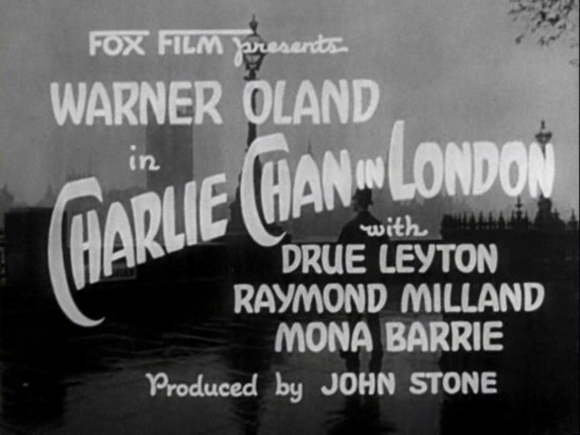
Although Gutterflower had ↵a fine association, nobody seems fit to solve the riddle, so here it is: The screencap is taken from ‘↑Charlie Chan in London‘ (Forde 1934). The artefact depicted is an airgun projectile. As ↑Inspector Chan (↑Warner Oland) draws closer and closer to the solution of the story’s mystery the murderer gets ever more nervous and makes an attempt on Chan’s life using said airgun:

The exotic weapon plays only a minor role in the movie, but I was struck by the design of its projectile. I can’t prove it, but I have a hunch that this design goes back to the very first science fiction comic strip.
The first installment of ‘↑Buck Rogers‘ was published on 07 January 1929—originally written by ↑Philip Francis Nowlan (1888-1940) and, from 1929 to 1947, pencilled and inked by ↑Dick Calkins (1895-1962). Early on in the story rocket ships appear which look quite similar to the projectile above. ‘Buck Rogers’ immediately got tremendously popular and was widely circulated. Even back then a merchandising industry already existed and soon matching toys were produced:

Rogers developed into a full-fledged franchise from which spawned movie serials, feature films, a 1980s television series and much more. The early success of Buck Rogers inspired ↑Alex Raymond (1909-1956) to create his own sci-fi hero comic strip: ‘↑Flash Gordon,’ which had its debut on 07 January 1934. In it we already find ‘our’ rocketship design. For illustration I chose a later strip, the Sunday strip of 08 September 1940, showing off Raymond’s artistry at its peak:
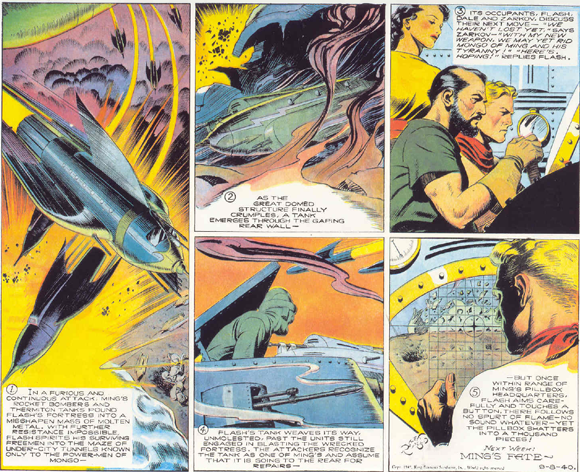
In the panel at the far left there are several characteristic rocket ships. The tank in the middle panel at the top follows the very same design language. By the way, at the top right you can see the epic’s main heroes, from left to right: ↑Dale Arden, ↑Dr. Hans Zarkov and Flash Gordon himself.
‘Flash Gordon’ in no time reached and even surpassed the popularity of ‘Buck Rogers.’ Already in 1936 a first movie serial was made, starring ↑Larry ‘Buster’ Crabbe as Gordon, ↑Jean Rogers as Arden, ↑Frank Shannon as Doctor Zarkov, ↑Priscilla Lawson as ↑Princess Aura, and ↑Charles Middleton as the Princess’ father, Emperor ↑Ming the Merciless (clearly inspired by ↑Sax Rohmer‘s evil genius, the sinister ↑Dr. Fu Manchu). In the serials of the time Crabbe played not only Flash Gordon, but Buck Rogers and ↑Tarzan, too. He was the ultimate hero icon, and, just like the soon to be iconic silver-screen Tarzan ↑Johnny Weissmuller, an Olympic swimming champion.
Here is a screencap from ‘The Planet of Peril’ (Stephani & Taylor 1936), the first episode of the first ‘Flash Gordon’ serial:

The rocket ship depicted is used by the soldiers of Emperor Ming who capture Arden, Gordon and Zarkov.

Here we can see the same rocket ship in full flight, bringing the captives to Ming’s citadel in the background. In the lower left corner, parked on the ground, is the ship in which our heroes travelled from Earth to the ↑planet Mongo. This ship was built in the USA by the earthling Dr. Zarkov but features the same design as Ming’s extraterrestrial ships. So the peculiar æsthetics were known on Earth, too. Little wonder then that the projectile meant for Charlie Chan looked alike.
flight assembled architecture
The ↑ETH Zurich‘s project ↑Flying Machine Enabled Construction … absolutely creepy :)
true skin
why technologies fail
Boingboing’s Maggie Koerth-Baker has written a fine column for the New York Times Magazine called ‘↑Why your car isn’t electric,’ investigating the question ↑why some technologies fail, and others succeed. For a deeper understanding of the matter at hand and and the examples used, I recommend Pinch & Bijker 1984 and Pfaffenberger 1992.
low poly mask

Stephen ‘kongorilla’ Kongsle designed this wearable cardboard mask and has put ↑all you need for it online under a creative commons licence. When I first saw it I immediately had three associations: 1) A ↑Bizarro t-shirt would go perfectly with the mask, 2) there was a time ↵when I perceived the everyday world around me like that, and 3) if you are learning to draw the human head and face this is a wonderful inexpensive tool for understanding the planes of the face. As it turns out association #3 hit it:
Sometime in the future I hope to make a full head version, but I wanted to post what I’ve gotten done so far in case someone could use it for Halloween 2012. The original idea was to make a papercraft alternative for artists who can’t afford the “planes of the head” plaster model, so keep your eyes peeled for further developments.
If you now feel an itch to do something with folding paper, go and watch ↑Vihart‘s ↑Hexaflexagons and ↑Hexaflexagons 2 … [there’s Richard Feynman in it :-]
the flash inspirations
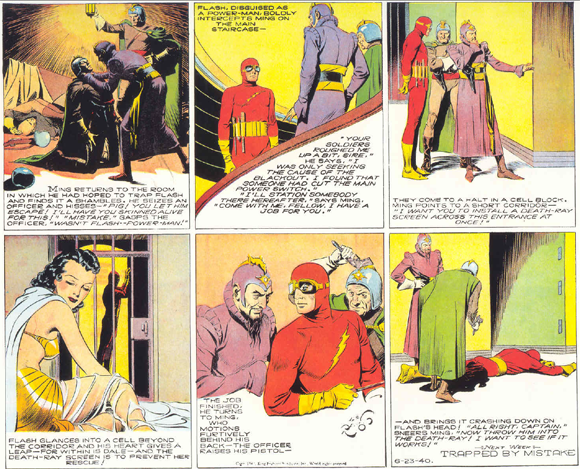
This is the King Features ‘↑Flash Gordon‘ Sunday strip by ↑Alex Raymond as it was published on 23 June 1940. We see Gordon [whose adventures began on 07 January 1934] disguised as a ‘Power-Man’ [‘the experts on whom Mongo’s electrified civilization depends’] infiltrating the palace of ↑Ming the Merciless—and being detected. Please note the design and colour-scheme of the Power-Man uniform Gordon is wearing. The full uniform first was depicted two weeks earlier, in one panel of the strip of 09 June 1940.
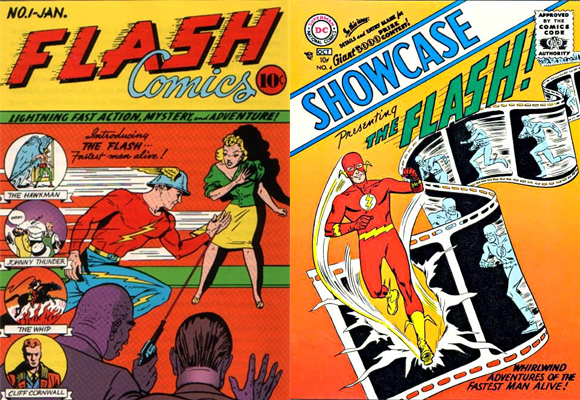
Earlier the same year the DC-superhero ‘↑The Flash‘ first appeared in Flash Comics #1, published in January 1940 [above left], drawn by Harry Lampert. The long-sleeved t-shirt worn by the fastest man alive is practically identical with the one of Flash Gordon as a Power-Man. The rest of the dress is totally different. Nevertheless does it seem like Raymond was inspired by the ↑Golden Age‘s speeding superhero.
The ↑Silver Age Flash had his debut in Showcase #4 [above right], pencilled by ↑Carmine Infantino and inked by ↑Joe Kubert. This time it seems to be the other way round: the inspiration for the superhero’s looks comes from Raymond’s work.
what is that?
zeph’s pop culture quiz #45
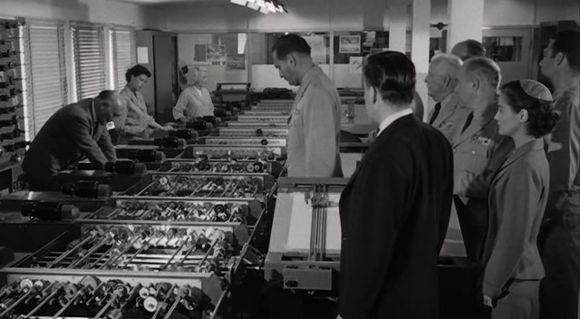
What is the large mechanical contraption in the picture everybody is staring at? In which movie does it appear and what does it do within the plot of that movie?
Just leave a comment with your educated guess—you can ask for additional hints, too. [Leaving a comment is easy; just click the ‘Leave a comment’ at the end of the post and fill in the form. If it’s the first time you post a comment, it will be held for moderation. But I am constantly checking, and once I’ve approved a comment, your next ones won’t be held, but published immediately by the system.]
UPDATE and solution (09 October 2012):
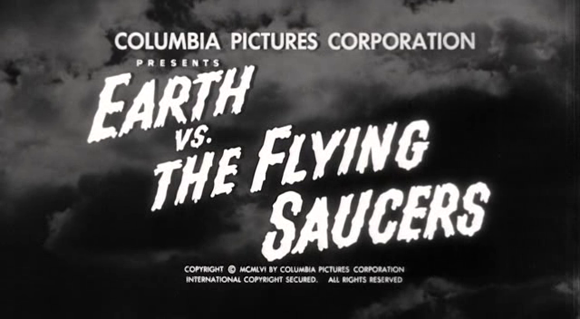
Once again Alexander Rabitsch ↵has done it: The machine is a Bush Differential Analyzer. About one hour into ‘↵Earth vs. The Flying Saucers‘ (Sears 1956) it helps to decrypt a message from the aliens. The machine seen in the movie belonged to the ↑UCLA and was installed there in 1947. The machine was the child of ↑Vannevar Bush (1890-1974) who had begun to work on this kind of analogue special purpose computers during the late 1920s.
‘My main effort was on the differential analyzer, which could mechanically solve differential equations.’ (Bush 1970: 161) Accordingly in 1927 Bush at ↑MIT starts to construct a practical version of the Differential Analyzer as invented by ↑James Thomson (1822-1892), elder brother of mathematical physicist and engineer ↑William Thomson, 1st Baron Kelvin (1824-1907). Once finished, in 1930, this analogue computer proofs to work flawlessly and is able to solve differential equations comprising up to 18 independent variables. (Puchta 1996)
A young doctoral student at the MIT is involved in the project—↑Claude Elwood Shannon (1916-2001). For his thesis he takes ‘the application of the techniques of classical Boolean algebra of classes to the study of switching systems in electrical engineering,’ (Wiener 1965 [1948]: 13) and thus creates digital circuit design theory.
‘We actually built three successive analyzers. The first one was just a breadboard machine. That is, it was made out of pieces of steel and anything else that was handy, […]‘ (Bush 1970: 182)—improvisation, and, much more important, rededication again.
During the 1930s Bush Analyzers are built in Great Britain, at Manchester, Cambridge, Belfast, and Farnborough, and in Oslo, Norway. During the early 1940s more incarnations follow in the United States, e.g. at Wright-Patterson Air Force Base and in the basement of the Moore School of Electrical Engineering at the University of Pennsylvania.
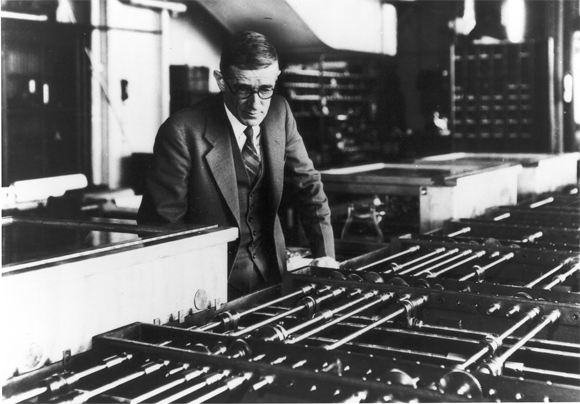
In 1941 an advanced version is constructed at MIT, called the ‘Rockefeller Differential Analyzer’ (RDA), because the Rockefeller Foundation largely has funded this apparatus of Babbageian dimensions, weighing 100 tons, comprising ‘2,000 electronic tubes, 200 miles of wire, 150 motors, and several thousand relays.’ (Wildes & Lindgren 1985: 92) Its predecessors are hard to set up for solving a particular problem, because the procedure requires e.g. manual reconnection of shafts. The RDA in contrast reads its instructions from three punched tapes.
With Vannevar Bush’s Differential Analyzer the story of the analogue computer, which started with the ↵Antikythera Mechanism, has come full circle and reaches its full bloom.
Nearby Hollywood also discovered the oversized computer [at UCLA], measuring some 31 feet long by 9 feet wide. In the era before “Star Wars” [Lucas 1977] and “Close Encounters” [Spielberg 1977] the differential analyzer was the latest in way-out gadgetry, and it performed skillfully in such science fiction epics of the mid-’50s as “When Worlds Collide” [Maté 1951] and “Earth vs. The Flying Saucers.” (Anonymous 1978)
games with defects
While attending the ↑Third Annual Conference of the Gesellschaft für Fantastikforschung (↑GFF), at the University of Zurich I got to know ↑René Bauer, a game designer who teaches at the Hochschule der Künste in Zürich (↑ZHdK). He showed us quite some of the projects done by his students—see yourself at ↑and-or—wonderful, fantastic, up to absolutely hilarious. I especially like the idea of creating computer games with built-in gameplay defects which are making you think. Take for example ‘↑laichenberg‘, a first-person shooter which was advertised as being ‘more realistic than doom3, unreal etc.’

With the graphics craze of the last decade one naturally assumes that the game features hyper naturalistic graphics to fulfill the claim. But the idea is totally different. Usually in fps-games wherein you rake up insane amounts of frags, the remains of the enemies you’ve overcome dissappear after a while. In ‘Doom 3’ the rationale for that happening is that the killed demons and zombies are returning to hell. In ‘Quake 3,’ or its reincarnation ‘Quake Live,’ the idea is that the Vadriggar, the unseen gamemasters of the arena, remove the fallen warrior who a moment later respawns. And so on. The real reason of course is that the corpses are not only irritating but strain the system which has to render them. Now, ‘laichenberg’ allows the corpses to remain in the game world. That way its archetypical fps-setting, a subterranean maze of bunkers, bit by bit gets filled up with the corpses—until the player can’t move anymore.

Another example which took my breath away is ↑‘Discrimination Pong‘—here’s how the developers themselves describe it:
DISCRIMINATION PONG is an anti-discrimination Pong-game. The GameArt project features some serious defects. It visualizes discrimination/racism, makes it playable and very tangible. The player experiences discrimination/racism first-hand while trying to establish a win in this unfair variation of Pong. The ‘not so white-paddle’ is discriminated in several aspects: from its visuals and its movements to the overall gamemechanic of the game. It is very hard for the discriminated player to win a match. Discrimination is implemented in different ways: the ‘not-so-white-paddle’ gets darker and darker. The left paddle may be slower than the right one. The ball may accelerate on the left side of the playground and become too fast to catch in time. The white paddle on the right may receive an extra ball without deserving it. And maybe worst of all, the ball never touches the right wall or paddle but loops slowly back to the left and takes on a faster pace as soon as it reaches the left side of the playground again. A very unfair game indeed! Find out what types of discrimination/racism you have to expect in DISCRIMINATION PONG.
Virtual worlds and above all games should be a place for equal access. Suggesting a ‘tabula-rasa-play’, as this variation of Pong does in its subtext, amounts to a vision of a world in which all actants have the same chance. But today more and more gamedesigners are willing to implement unfair elements in their games like the option to buy game-relevant items with real currency for personal (in-game) gain.

